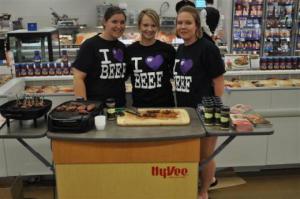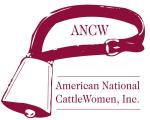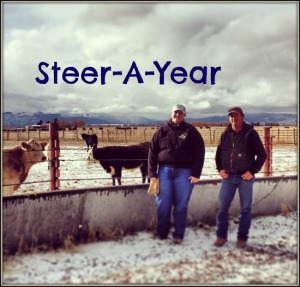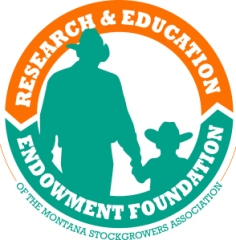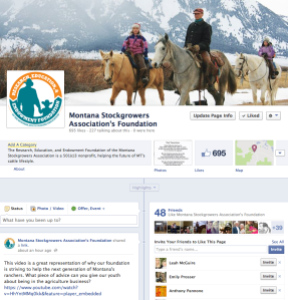 (via NCBA, Beltway Beef) The House Committee on Agriculture hosted a hearing last week to review the state of the livestock industry. Representing the National Cattlemen’s Beef Association, the North American Meat Association and Harris Ranch, Mike Smith came to D.C. to discuss the beef industry.
(via NCBA, Beltway Beef) The House Committee on Agriculture hosted a hearing last week to review the state of the livestock industry. Representing the National Cattlemen’s Beef Association, the North American Meat Association and Harris Ranch, Mike Smith came to D.C. to discuss the beef industry.
Smith works for Harris Ranch, one of the nation’s largest family-owned agribusinesses in the western United States. A diversified company, Harris Ranch feeds roughly 250,000 head of cattle each year and operates one of the largest feedlots in the U.S., as well as farming over 17,000 acres, operating one of the largest thoroughbred horse farms, and running a 150-room inn and restaurant complex.
Noting the hard times the beef industry has faced over the past few years, Smith discussed five issues directly impacting the industry: drought, federal regulations, taxes, trade and country-of-origin labeling.
Hailing from California, Smith said he is all too familiar with the lack of water plaguing the U.S. California is facing the worst drought in recorded history and federal and state regulations to restrict water allocation has only made the drought worse for farmers and ranchers. The Endangered Species Act severely restricts water access and has caused hardship for many producers across the country, Smith said.
“It’s not just the ongoing drought that is hurting our industry,” Smith said. “The onslaught of Federal rules and regulations continue to put pressure on the growth of America’s cattle herd. In California, we are already subject to more rules and regulations than any other cattle producing state. These state rules are compounded by the rules coming from agencies such as the EPA.”
EPA’s proposed rule to redefine the Waters of the United States has raised concerns about the expanding jurisdiction the EPA and the U.S. Army Corps of Engineers. Under this proposal, it is likely some cattle producers will have to file for a permit to conduct activities on their private property.“Effectively, this amounts to a huge land grab by EPA and directly threatens long-established private property rights,” said Smith.
Another area of concern is transportation. Obsolete and ridiculous rules such as the U.S. Department of Transportation’s “30-minute” rule endangers the welfare of livestock by stopping the airflow through the trailer, causing added stress to the cattle, said Smith. Similarly, by adding an additional axle, increased truck weights would allow more cattle to be shipped with fewer truck loads while causing less wear and tear on roads and bridges than there is now. Smith urged the Congress to address transportation reauthorization and look at ways to maximize shipping capabilities.
Addressing the issue of taxes, Smith said that is extremely important that Congress take urgent action to make permanent the tax extenders package made up of the tax provisions which expired in 2013 – particularly the section 179 at a level of $500,000. Section 179 allows producers to who purchase new equipment to depreciate the value quicker at a larger amount.
“We can’t talk about taxes without mentioning the Death Tax,” said Smith. “Even though Congress made improvements to the Death Tax provisions at the end if 2012, we still full repeal. In order to make sure that a future Congress does not revert back to the $1 million exemption, it is imperative that we finally repeal the Death Tax once and for all.”
Trade has been a top priority for the cattle industry. International markets give the mature and developed cattle industry more opportunity for expansion as countries with an increasing middle class have more disposable income and want a higher quality diet. Ongoing negotiations to conclude the Trans Pacific Partnership will define beef trade between the U.S. and Japan. Smith said support of a TPP deal should only come if the tariffs Japan is demanding are eliminated. Trade agreements are currently worth roughly $300 per head, nearly 20 percent of fed cattle’s overall value. Trade is important, and should be based on sound science, said Smith. USDA’s Animal and Plant Health Inspection Service has proposed a rule that would allow certain states within Brazil to ship fresh and frozen beef into the United States. Smith explained that the issue is Brazil still has a problem with Foot-and-Mouth Disease, an economically devastating disease the U.S. eradicated in the early 1900’s.
Even more concerning, said Smith, is that APHIS does not seem to be adequately prepared for this proposed rule. Many of the documents used to formulate the proposed rule were in Portuguese with no translation and many of the documents requested through the Freedom of Information Act were not received.
Wrapping up his testimony, Smith explained the burden of country-of-origin labeling. Proponents of COOL have long said that mandatory labeling would cause the U.S. consumer to pay more for U.S. beef, but five years of implementation has proved the opposite. Kansas State University conducted a study on COOL which showed the vast majority of consumers do not even look at the COOL label when buying beef. On top of that, COOL has caused two of our largest trading partners to file a case with the World Trade Organization against the United States. If they win, they will be able to retaliate against the beef industry.
“If we lose access to those markets, or they are restricted by the enactment of tariffs, that will have a negative impact on all U.S. producers,” said Smith. “We remain perplexed why our government wants to hurt our industry for a simple marketing program that has proven to be ineffective. COOL is all about marketing and has absolutely nothing to do with food safety. Those who use that argument know nothing about the food safety protocols in this country.”













